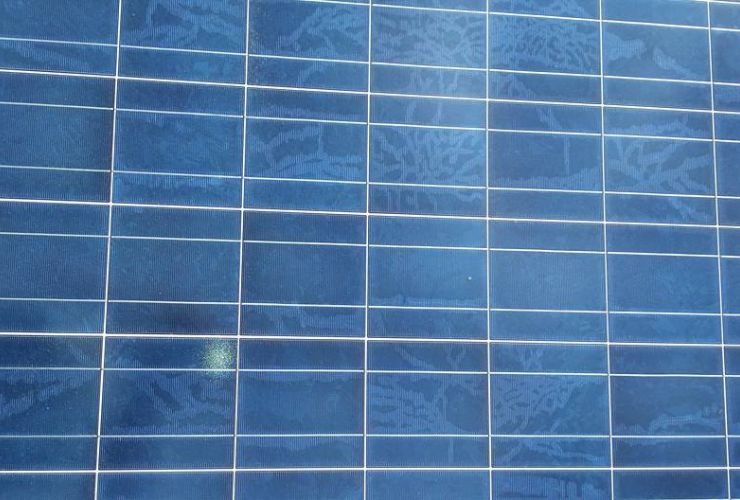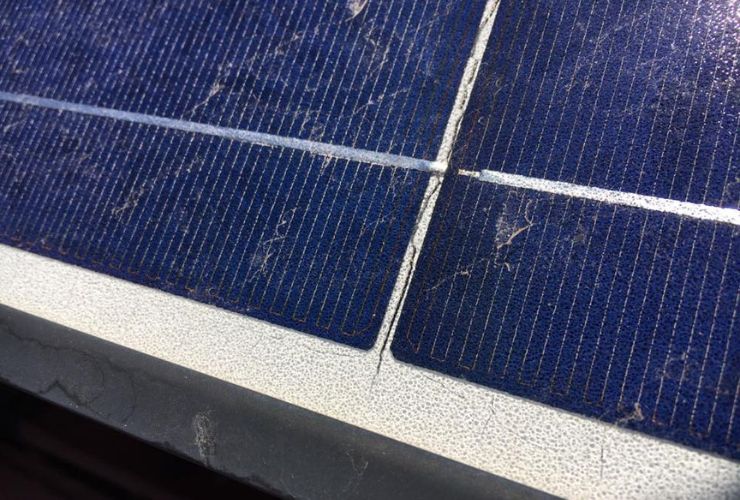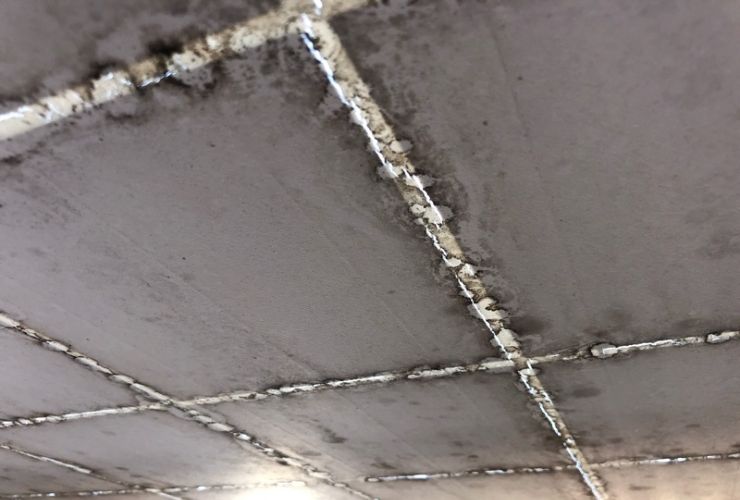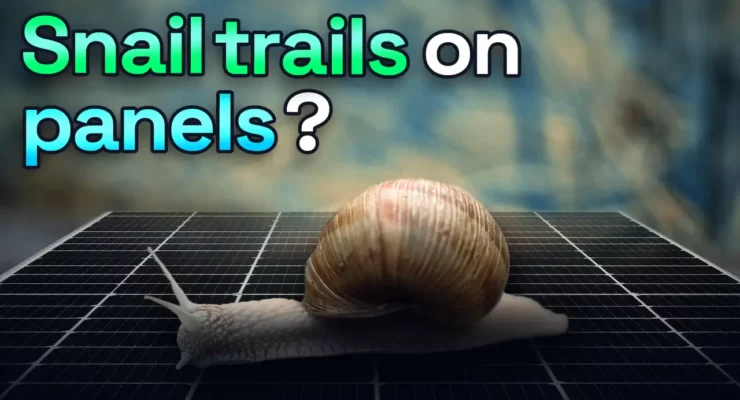Fast read
Solar panels can develop "snail trails"—silvery, brown slivery patterns inside the panel - under the glass not caused by actual snails but indicative of potential issues in the modules.
These trails have become noticeable in solar cells over the past 10-15 years, especially in mono and polycrystalline silicon panels.
Their cause is primarily moisture between cells and EVA encapsulant, which can come from humidity during manufacturing or micro-cracks in the cells.
This moisture reacts with oxygen and silver nanoparticles, leading to discolouration. Though primarily aesthetic, snail trails can hint at microcracks and potential panel issues. Prevention includes investing in high-quality panels, ensuring proper transport, and employing a solar company that follows best installation practices.
Understanding snail trails on solar panels: Causes, consequences, and solutions
Quality solar panels, whilst built to last for decades, can occasionally exhibit a phenomenon known as “snail trails”. These trails resemble the silvery patterns a snail might leave behind when slithering across a surface. They are indicative of potential issues in the solar photovoltaic modules. So can snail trails seriously impact the functionality of solar panels?
What are snail trails on solar panels?
Snail trails are probably not what you think they are, no, they are not slimy lines left on your solar panels from snails. Snail trails have been an occurrence that has become prominent between 10 to 15 years ago on solar cells and appear as silverish lines below the glass.
They appear once panels have been installed and operational for some time (usually after several months to a few years). Snail trails are characterised by a brownish, silver discolouration on solar cells around the edges of the cells or across the cells.
These patterns are particularly noticeable in Mono and Polly crystalline full-cell silicon solar panels. They are a matter of concern for many solar panel owners when they are noticed for the first time.

What causes these snail trails?
Research has found that snail trails are caused first by moisture between the cells and EVA encapsulant on either side of the cell. This moisture can be present because of excessive humidity within the production facility during manufacturing.
It also can be caused later by microcracks within the cells. This can lead to moisture leaching through the foil back sheet and into the cell area. The moisture can then pass through the cell cracks and around cell edges to the front of the solar cell surface.
The moisture then reacts with oxygen and silver nanoparticles in the conductive fingers on the solar cell. It then leads to the dissolving of the silver surface and a further chemical reaction with the encapsulant. This causes the brown discolouration of the EVA encapsulant.
So, snail trails are caused by a chemical reaction inside PV panels. Depending on the severity, this chemical reaction can cause some degradation, and your solar output will potentially decrease.
Unfortunately, once the discolouration has occurred, it is irreversible. The good news is that it often does not get worse after discovery.
So the three combined “culprits” in the snail trail saga are:
- EVA encapsulant: Solar panels utilise an EVA (ethylene vinyl acetate) encapsulant that binds the solar cells to the glass surface and the back sheet. This material safeguards the cells by providing mechanical protection and electrical insulation.
- Moisture ingress: The introduction of moisture, either because of defects in the sealing of the panel or due to extended exposure to humid conditions, can act as a catalyst. This moisture can either originate from excessive humidity during manufacturing or seep through microcracks in the cells. This moisture then allows it to penetrate the foil back sheet and access the cell area.
- Chemical reaction with silver: The silver in the metallisation paste of the solar cells reacts with the EVA encapsulant when moisture is present. When moisture reacts with the silver nanoparticles in the conductive fingers on the solar cell, it causes the silver surface to dissolve. This reaction forms silver nanoparticles that can move, resulting in the snail trail look.

What are the effects of snail trails on solar panels?
Research and testing by major panel manufacturers have shown that snail trails often do not significantly lose the solar panel’s performance. Snail trails across or within the cells often indicate microcracks. Microcracks create the environment for the chemical reaction to occur but also can affect panel performance.
Snail trails, therefore, become a key visual indicator for microcracks in a solar panel. Such cracks should be monitored over time for the potential to create hotspots and panel failure. Microcracks are hairline fractures within the solar cell caused by poor quality controls and handling within manufacturing, transport, installation or subsequent maintenance activities such as cleaning the panels with a pressure sprayer.
Snail trails could imply issues with the panel’s manufacturing process or materials. High-quality solar panel manufacturers usually have fewer problems with snail trails.
How do we mitigate and prevent snail trails?
Prevention is the best way to deal with snail trails.
- Invest in quality: Opting for top-notch solar modules from well-known manufacturers can lower the risk. These manufacturers often employ advanced materials and handling techniques that minimise snail trail formation.
- Use alternative encapsulants: Some manufacturers are exploring alternative encapsulants, such as polyolefin elastomer (POE) or polyvinyl butyral (PVB). This encapsulant is likely to reduce the tendency for snail trails. The more modern panels now use different encapsulation materials, meaning snail trails are more likely in modules 5 to 12 years old.
- Ensure proper sealing: Keeping panels well-sealed against moisture ingress is crucial. No walking on the panel or cleaning with high pressure. Proper installation and regular inspections can detect and address any sealing issues.
- A quality solar panel installer will adopt best practices during installation. Correct handling during installation ensures the panels aren’t subjected to unnecessary stress. This reduces the likelihood of defects or microcracks contributing to moisture ingress or snail trail formation.

Conclusion
In conclusion, while snail trails on solar panels might look like just a cosmetic issue, they can sometimes mean there are deeper problems. These streaks can be caused by things like faults in the panels or mistakes made during installation.
Choosing good-quality solar panels can help reduce the chance of getting snail trails and other issues. It’s worth picking well-known brands that are durable and can handle different weather conditions.
The installer you choose is also important. A good installer will follow the right steps to install your solar panels correctly, which can help prevent problems like snail trails.
It’s also a good idea to keep your solar panels clean and well-maintained. This can help spot and fix any issues early on, keeping your panels working well for longer.



